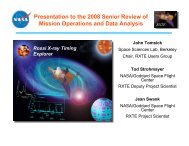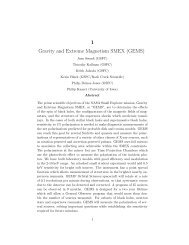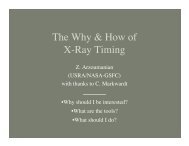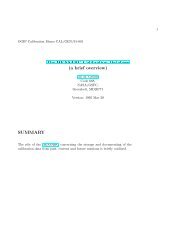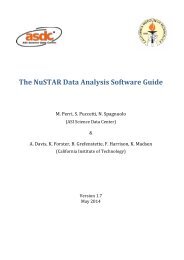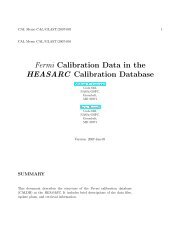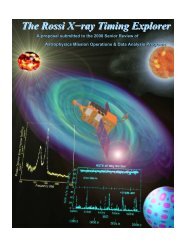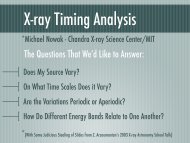CCfits - HEASARC - NASA
CCfits - HEASARC - NASA
CCfits - HEASARC - NASA
Create successful ePaper yourself
Turn your PDF publications into a flip-book with our unique Google optimized e-Paper software.
4 Xspec and <strong>CCfits</strong> 9<br />
4. They provide slicing operations [see the "Getting Started" section for a<br />
simple example].<br />
• Exceptions are provided in for by a FitsException hierarchy, which prints out<br />
messages on errors and returns control to wherever the exception is caught. -<br />
Non-zero status values returned by cfitsio are caught by subclass FitsError, which<br />
prints the string corresponding to an input status flag. FitsException’s other subclasses<br />
are thrown on array bounds errors and other programming errors. Rare<br />
[we hope] errors that indicate programming flaws in the library throw FitsFatal<br />
errors that suggest that the user report the bug.<br />
4 Xspec and <strong>CCfits</strong><br />
This section is provided for background. Users of <strong>CCfits</strong> need not read it except to<br />
understand how the library was conceived and therefore what its strengths and weaknesses<br />
are likely to be in this initial release.<br />
4.1 About XSPEC<br />
XSPEC is a general-purpose, multi-mission X-Ray spectral data analysis program<br />
which fits data with theoretical models by convolving those models through the instrumental<br />
responses. In XSPEC 11.x and all prior versions that use FITS format data,<br />
each individual data file format that is supported can have up to 4 anciliary files. That<br />
is, for each data file, there can be a response, correction, background and auxiliary<br />
response (efficiency) file. Additionally there are table models that read FITS format<br />
data. All told, therefore, much duplicated procedural code for reading FITS data can<br />
be eliminated by use of the greater encapsulation provided by <strong>CCfits</strong>. XSPEC’s primary<br />
need is to read FITS floating point Binary Tables. XSPEC also creates simulated<br />
data by convolving users’ models with detector responses, so it also has a need for writing<br />
tabular data. Images are not used in XSPEC. We have provided a support for image<br />
operations which has undergone limited testing compared to the reading interface for<br />
table extensions.<br />
4.2 New Data Formats<br />
New formats to be read in XSPEC that are specialized for a particular satellite mission<br />
can be supported almost trivially by adding new classes that read data specified with<br />
different FITS format files. A single constructor call specifying the required columns<br />
and keys is all that is needed to read FITS files, rather than a set of individual cfitsio<br />
calls. The library is designed to encourage the “resource acquisition is initialization”<br />
model of resource management; <strong>CCfits</strong> will perform more efficiently if data are read<br />
on construction.<br />
Generated on Tue Dec 6 2011 16:12:51 for <strong>CCfits</strong> by Doxygen



